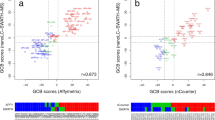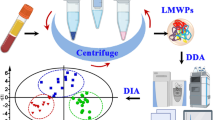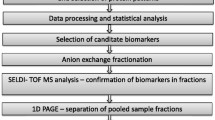Abstract
The aim of this study was to identify potential serum biomarkers of diffuse large B-cell lymphoma (DLBCL) and to detect DLBCL therapy response biomarkers. DLBCL serum proteomic analysis was performed using the CM10 ProteinChip mass spectrometry (SELDI-TOF-MS) approach combined with bioinformatics. A total of 178 samples were analyzed in this study from untreated early stage DLBCL patients (38), patients with inflammatory lymphadenopathy (13), healthy donors (35), post-treatment non-relapsed DLBCL patients (53), and relapsed DLBCL patients (39). Model 1 formed by nine protein peaks (m/z: 6443, 5913, 6198, 4098, 7775, 9293, 5946, 5977, and 4628) could be used to distinguish DLBCL patients from healthy individuals with an accuracy of 95.89 % (70/73). The diagnostic pattern constructed using the support vector machine including the nine proteins of model 1, showed a maximum Youden’s Index. Model 2 formed by three protein peaks (m/z: 3942, 6639, and 4121) could be used to distinguish DLBCL patients from those with inflammatory lymphadenopathy with an accuracy of 94.12 % (48/51). Model 3 formed by six protein peaks could distinguish patients with inflammatory lymphadenopathy from healthy individuals with an accuracy of 97.92 % (47/48). Model 4 could be used to distinguish non-relapsed DLBCL patients from relapsed DLBCL patients with an accuracy of 84.78 % (78/92). The four patterns were validated by leave-one-out cross-validation. These data demonstrate that the CM10 ProteinChip and SELDI-TOF-MS approach combined with bioinformatics can be used effectively to screen for the differential protein expression profiles of DLBCL patients and to predict the response to therapy.


Similar content being viewed by others
References
Siegel R, Naishadham D, Jemal A. Cancer statistics. CA Cancer J Clin. 2013;63:11–30.
Jardin F. Next generation sequencing and the management of diffuse large B-cell lymphoma: from whole exome analysis to targeted therapy. Discov Med. 2014;18:51–65.
A clinical evaluation of the International Lymphoma Study Group classification of non-Hodgkin’s lymphoma. The Non-Hodgkin’s Lymphoma Classification Project. Blood.1997; 89:3909–18.
A predictive model for aggressive non-Hodgkin’s lymphoma. The International Non-Hodgkin's Lymphoma Prognostic Factors Project. N Engl J Med. 1993; 329:987–94.
Shipp MA, Ross KN, Tamayo P, Weng AP, Kutok JL, Aguiar RC, et al. Diffuse large B-cell lymphoma outcome prediction by gene-expression profiling and supervised machine learning. Nat Med. 2002;8:68–74.
Xu WH, Chen YD, Hu Y, Yu JK, Wu XG, Jiang TJ, et al. Preoperatively molecular staging with CM10 ProteinChip and SELDI-TOF-MS for colorectal cancer patients. J Zhejiang Univ Sci B. 2006;7:235–40.
Cao XL, Li H, Yu XL, Liang P, Dong BW, Fan J, et al. Predicting early intrahepatic recurrence of hepatocellular carcinoma after microwave ablation using SELDI-TOF proteomic signature. PLoS One. 2013;8(12):e82448. doi:10.1371/journal.pone.0082448. eCollection 2013.
Zheng GB, Gao CF, Wang XL, Zhao G, Li DH. Study on serum proteomic features in patients with and without recurrence or metastasis after surgical resection of esophageal carcinoma. Genet Mol Res. 2014;13:538–45.
Liu C, Pan C, Wang H, Yong L. Effect of surface-enhanced laser desorption/ionization time-of-flight mass spectrometry on identifying biomarkers of laryngeal carcinoma. Tumour Biol. 2011;32:1139–45.
Rogers MA, Clarke P, Noble J, Munro NP, Paul A, Selby PJ, et al. Proteomic profiling of urinary proteins in renal cancer by surface enhanced laser desorption ionization and neural-network analysis: identification of key issues affecting potential clinical utility. Cancer Res. 2003;63:6971–83.
Somorjai RL, Dolenko B, Baumgartner R. Class prediction and discovery using gene microarray and proteomics mass spectroscopy data: curses, caveats, cautions. Bioinformatics. 2003;19:1484–91.
Wang JX, Yu JK, Wang L, Liu QL, Zhang J, Zheng S. Application of serum protein fingerprint in diagnosis of papillary thyroid carcinoma. Proteomics. 2006;6:5344–9.
He H, Sun G, Ping F. Laser-capture microdissection and protein extraction for protein fingerprint of OSCC and OLK. Artif Cells Blood Substit Immobil Biotechnol. 2009;37:208–13.
Qiu FM, Yu JK, Chen YD, Jin QF, Sui MH, Huang J. Mining novel biomarkers for prognosis of gastric cancer with serum proteomics. J Exp Clin Cancer Res. 2009;28:126. doi:10.1186/1756-9966-28-126.
Han M, Liu Q, Yu J, Zheng S. Identification of candidate molecular markers predicting chemotherapy resistance in non-small cell lung cancer. Clin Chem Lab Med. 2010;48:863–7.
Yang S, Nan Y, Tian Y, Zhang W, Zhou B, Bu L, et al. Study of distinct protein profiles for early diagnosis of NSCLC using LCM and SELDI-TOF-MS. Med Oncol. 2008;25:380–6.
Xu W, Chen Y, He W, Fu Z, Pan T, He H, et al. Protein fingerprint of colorectal cancer, adenomatous polyps, and normal mucosa using ProteinChip analysis on laser capture microdissected cells. Discov Med. 2014;17:223–31.
Acknowledgments
This work was supported by the Youth Program of Natural Science Foundation of China (30901686); Zhejiang Provincial Natural Science Foundation of China (LQ13H160015 and LY14H160031); Research Program 2013KYB247 from Hygiene Bureau; Research Program Y201432699 and Y201225136 from the Education Bureau, Zhejiang Province, China; the National High Technology Research and Development Program of China (863 Program) (2012AA02A204); and the National Natural Science Foundation of China (Grant number: 81202097).
Conflicts of interest
None.
Author information
Authors and Affiliations
Corresponding author
Rights and permissions
About this article
Cite this article
Xu, W., Hu, Y., He, X. et al. Serum profiling by mass spectrometry combined with bioinformatics for the biomarkers discovery in diffuse large B-cell lymphoma. Tumor Biol. 36, 2193–2199 (2015). https://doi.org/10.1007/s13277-014-2830-z
Received:
Accepted:
Published:
Issue Date:
DOI: https://doi.org/10.1007/s13277-014-2830-z




